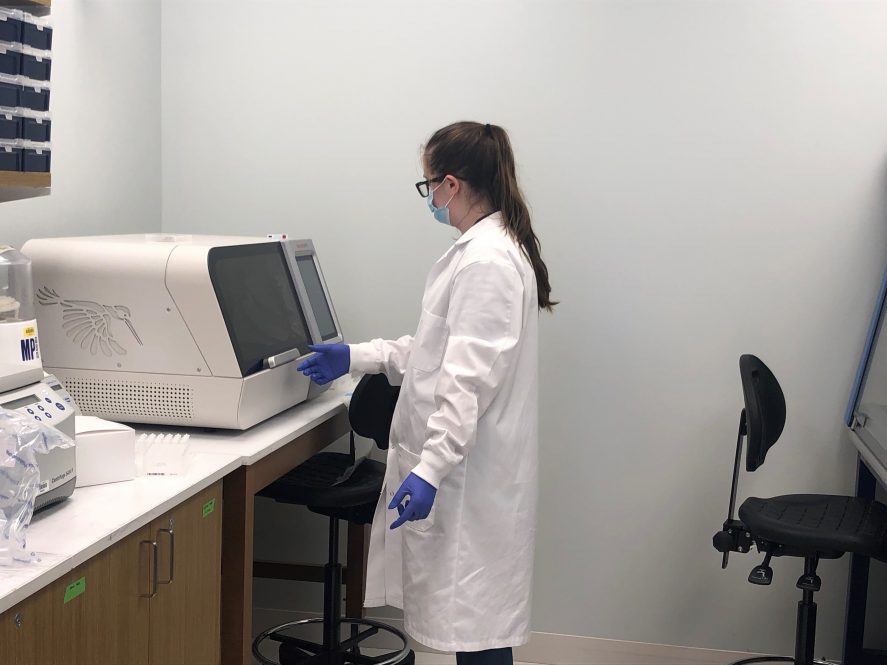As a newly designated wastewater-based epidemiology Center of Excellence, UConn has greater ability to support public health across the state by testing for COVID-19 and other viruses.
Ceres Nanosciences named UConn as one of nine of the country’s Centers of Excellence, in the process awarding the University a portion of an $8.2 million National Institutes of Health grant. The distinction validates UConn’s efforts as one of the first universities in the nation to test its own wastewater for the presence of COVID-19.
“Being named as a Center of Excellence is fantastic because it recognizes how members of UConn’s SARS-CoV-2 Surveillance network, and its students, really came together to set the standard for making the campus safe and able to reopen,” says Director of the Institute for Systems Genomics and Professor of Molecular and Cell Biology Rachel O’Neill.
Shortly after a person contracts SARS-CoV-2 – the coronavirus responsible for COVID-19 – they begin to shed large amounts of the virus through their feces, typically before displaying any symptoms of illness. UConn’s SARS-CoV-2 Surveillance network began testing wastewater at sites throughout the Storrs campus in an attempt to determine exact points where the virus was entering the wastewater system. By identifying the source of the entry, the University could limit the scope of a potential outbreak.
Scientific Director Kendra Maas and her student-centered team at the Microbial Analysis, Resources, and Services (MARS) facility, in collaboration with the Institute for Systems Genomics, Facilities and Student Health and Wellness, developed UConn’s wastewater testing protocols. The lab tested samples beginning in the spring of 2020, at the onset of the outbreak.
Maas used a Ceres-developed Nanotrap Magnetic Virus Particle method, which enables rapid viral concentration directly from raw sewage, thus reducing the time and effort needed to process wastewater samples. Her team has since expanded testing methods, employing a high density, absorbent material to collect samples.
Wastewater testing on campus was so successful that UConn extended efforts across the state. Testing began at sites throughout New England, including the University of Hartford, the U.S. Coast Guard Academy, towns such as Manchester, Windham, and Glastonbury, and even a sleepaway camp.
MARS facility scientist Lisa Nigro says that prior to being named a Center of Excellence, the lab could handle about 20 wastewater samples per day, with faculty and students working together to complete the task. As a result of Center of Excellence status and the corresponding NIH grant, UConn was able to purchase a robot called the Kingfisher Apex – technology that quadruples the number of wastewater samples that MARS can analyze daily.
O’Neill says that the expanded testing capacity has benefits beyond testing for COVID-19. MARS will have the capability to test for other viruses, such as influenza, that create public health crises.
Nigro said the work has been transformative for MARS faculty and students, who continue to diligently test wastewater and other fluids for the presence of coronavirus. The MARS team consists of recent UConn graduate Samantha Morales, graduate student Lucy Owusu, and five undergraduate students: Tanner Trosell, Amandeep Simran Kaur, Fiona Casey, Jordan Buslewicz, and Mahmoud Mazloum. They have diverse majors and backgrounds, including engineering, Earth sciences, and health sciences.
The interdisciplinary team provides unique angles for troubleshooting and developing methods. “It has been a pleasure to work with these students,” Nigro says. “They have been an essential part of the program’s success.”
Wastewater testing was one of several successful initiatives that UConn implemented to safely reopen the campus during the pandemic. O’Neill and Maas were the primary investigators on a $50,000 grant from the Office of the Vice President for Research awarded to implement an integrated surveillance program for improved detection, containment, and mitigation of COVID-19.
Ceres chose the Centers of Excellence based on their capabilities to extend services into underserved communities and provide critical information to public health decision makers. Sites receive materials and training that enables greater capacity for testing and improves turnaround times to less than eight hours.
“These sites encompass non-profit, university, public health, and commercial testing labs in eight states with a total population of more than 120 million people,” says Tara Jones-Roe, Vice President of Sales and Marketing for Ceres. “We are very proud of this amazing set of organizations and look forward to identifying additional sites.”



